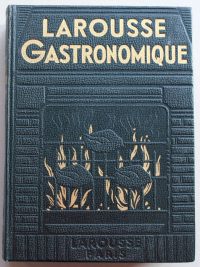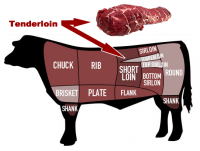Take it from Sam Elliott and Hannibal Lecter: You can’t go wrong with chateaubriand.

Let’s talk about meat and serial killers, shall we?
If you’ve seen the 2002 movie Red Dragon, you might remember how FBI agent Will Graham visited Hannibal Lecter, picked up a cookbook in Lecter’s office, saw an entry about sweetbreads, then realized too late that Lecter was the serial killer he’d been looking for.
That cookbook was Larousse Gastronomique, a 20-pound encyclopedia of French cuisine (which Lecter was using for a sweetbread recipe, but instead of calf or lamb organs-—thymus or brains or pancreas or whatever—-he served his guests an amuse bouche made from a tone-deaf flautist from the Baltimore Symphony).

Larousse Gastronomique, which was written by a guy named Prosper Montagné, says a chef named Montmireil created Chateaubriand in 1822, naming it after his boss, the Vicomte François-René de Châteaubriand, who in turn was the French ambassador to England and who looked a lot like David Tennant, who played Doctor Who, all of which means that Sam Elliott can do voiceovers for beef commercials, which sell lots and lots and lots of beef.

Got all that?
Okay, good. So the point here is that Chateaubriand isn’t a recipe; it’s a cut of meat. Specifically, it’s part of the tenderloin, aka the psoas major muscle.

The psoas major does very little work, so it’s the most tender cut of beef. A number of fancy cuts come from the tenderloin: Filet mignon; fillet steak (for Beef Wellington); tournedos; the butt end, etc.
Chateaubriand is the center of the tenderloin; it’s usually sold in one piece weighing 12 to 16 oz.
One Chateaubriand cut generally serves two, so if you’re serving more, just make more marinade.
- Ingredients:
- 1 Chateaubriand
- 2–4 cups of soy sauce
- 1 cup olive oil
- 12 oz. water
- 2 tbsp. garlic powder
- 1 cup freshly squeezed lemon juice
- 1 cup brown sugar
- 1–2 tbsp. black pepper
Directions
Combine ingredients and marinate 8 to 12 hours, turning or basting occasionally. Don’t throw the marinade or any juices out; save them for when it’s time to cook.
Preheat oven to 425° F.
Put the meat on a roasting rack in a baking dish.
For rare or medium-rare or medium, respectfully, cook until the center is about 120° or 130° F.
Cover loosely with foil; let rest for 15 minutes.
If you’re feeding any uncivilized barbarians who want it medium, medium-well, or even (gasp) well-done, take it out of the oven when it’s medium-rare anyway, then finish their slices off in a skillet with a little olive oil.
Cut into 1/4‑inch slices; cook a little more in a skillet if needed, and serve.
